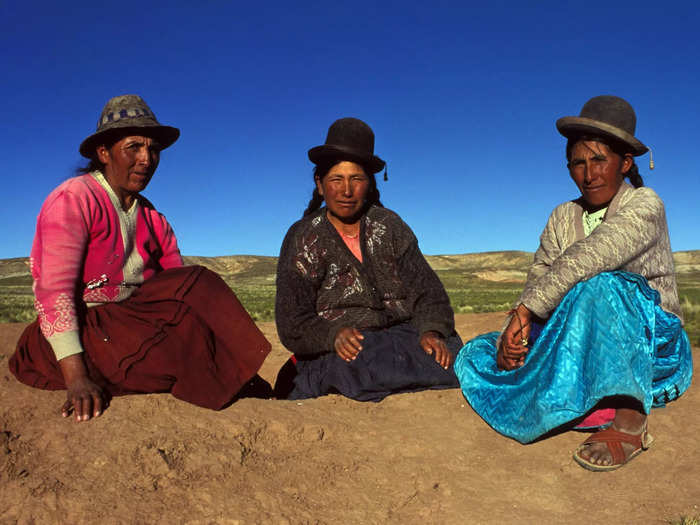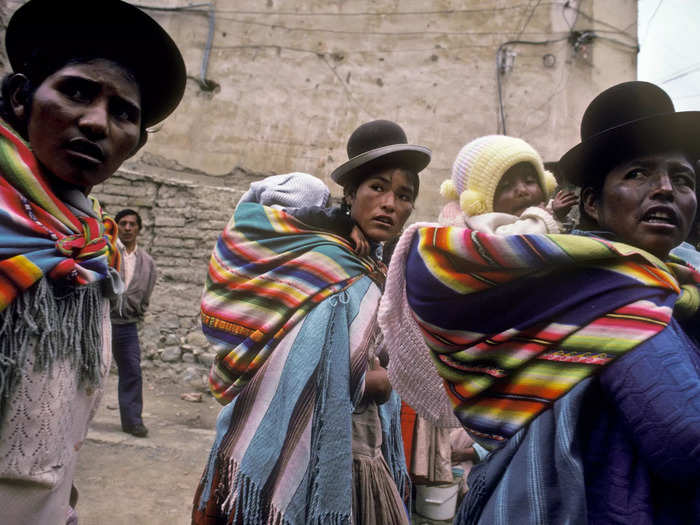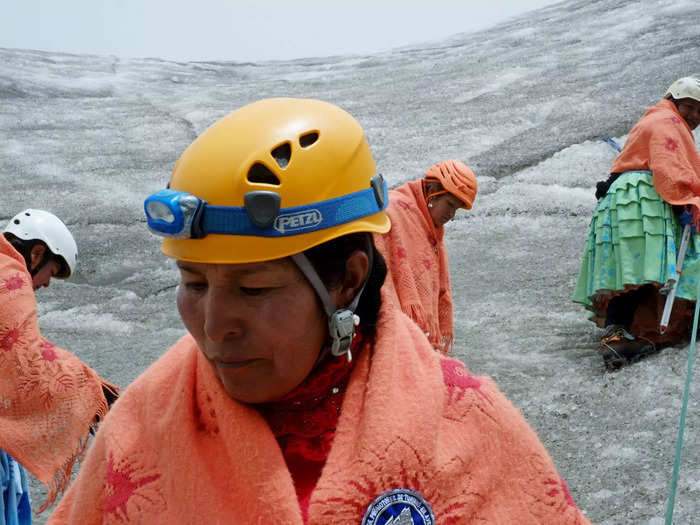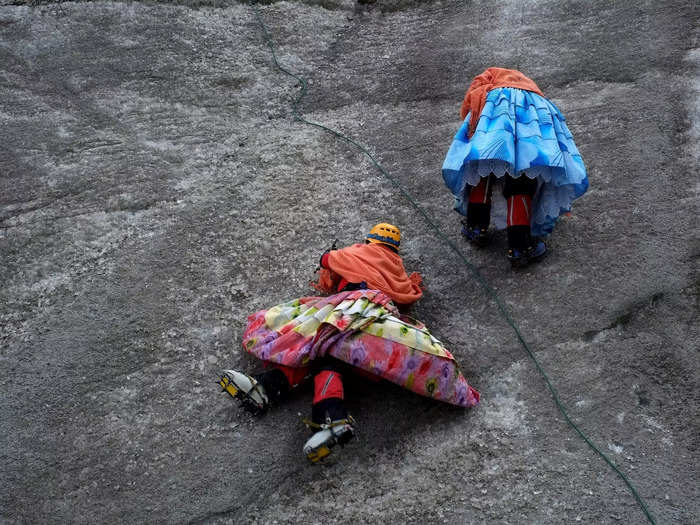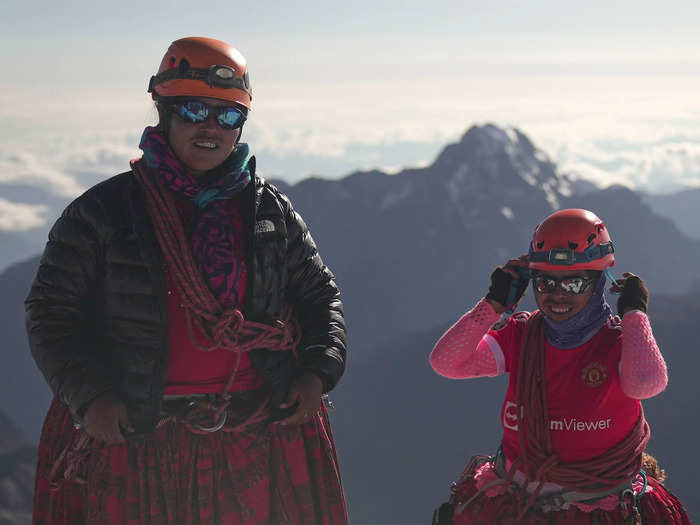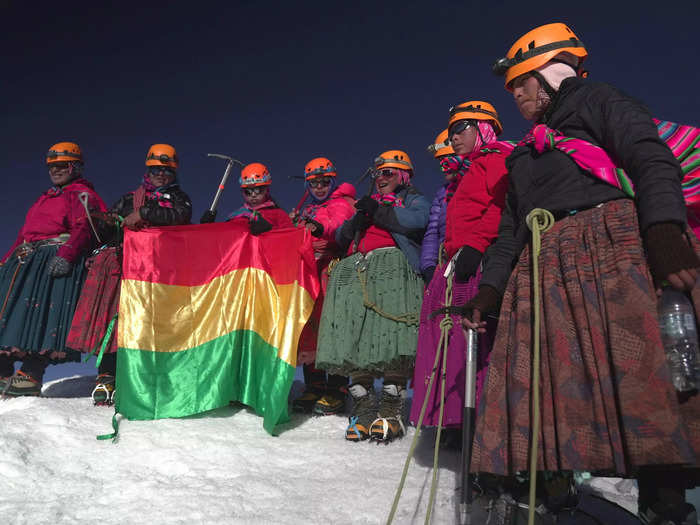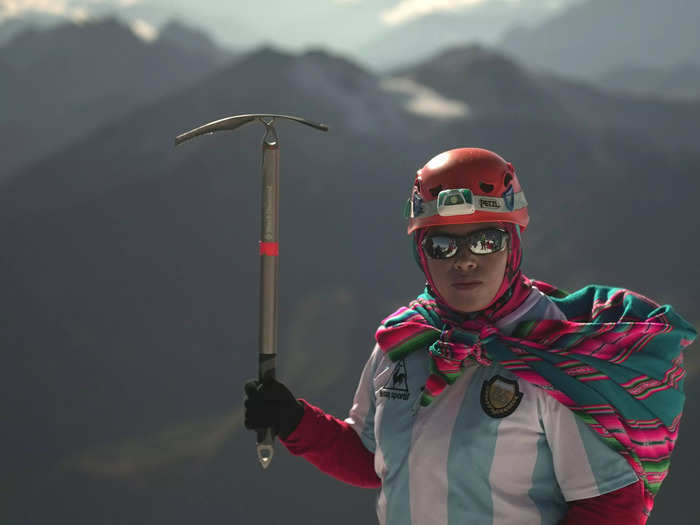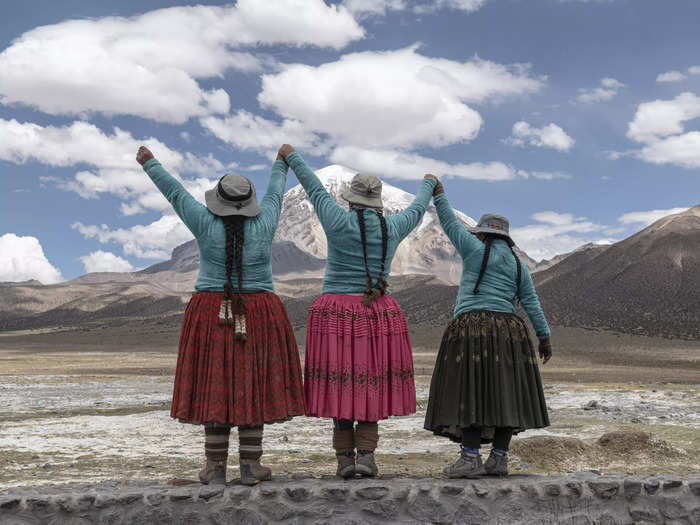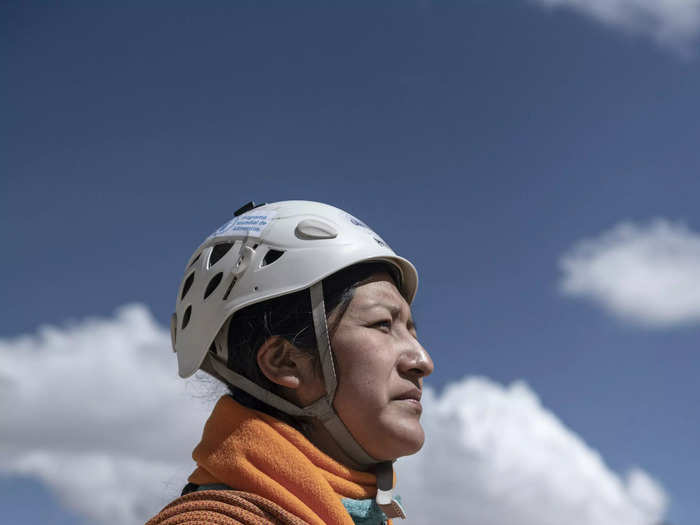A mountain guide in the Cholita climbers group passes in front of a no trespassing sign.REUTERS/Claudia Morales
- In 2015, a group of 11 Aymara Indigenous women set out to climb the mountains of Bolivia.
- The group, known as Cholita Climbers, make their ascent in traditional Aymaran clothes.
Dressed in bright clothing, a group of Indigenous Aymara women climb the peaks of the Cordillera Real mountain range in Bolivia.
The group of 11 women, all between 40 and 50 years old, are thought to be the first Aymara women to ascend the peaks of the Cordillera Real mountain ranges. Traditionally working in roles as porters and cooks at base camp for visiting mountaineers, the Aymara women have traded their cooking utensils for climbing tools.
Making their first ascent in 2015, the climbers have since made it to the top of five Bolivian peaks — the Acotango, Parinacota, Pomarapi, and Huayna Potosi, as well as Illimani, which has a 5-mile long series of four peaks. All peaks are higher than 19,500 feet above sea level.
In January 2019, the Cholita climbers achieved their long-term goal of summiting Aconcagua, the tallest mountain outside of Asia, with its peak at 22,841 feet.
The Cholita Climbers are a group of Indigenous Aymara women from Bolivia.
Aymara women in the Altiplano. Julio Etchart/ullstein bild via Getty Images.
Aymara women are recognizable by the way they dress, with colorful skirts and wool bowler hats as part of their traditional clothing.
The traditional clothing of the Cholitas originates from Spanish colonizers in the 17th century.
Aymara mothers carry their children on their backs. In Pictures Ltd./Corbis via Getty Images
When Spain came to the Americas, Viceroy Francisco de Toledo banned Inca clothing and instead ordered people to wear clothing seen in the mountains of Spain.
Over the centuries, the components of the outfits have changed in material but have largely remained the same style, including petticoats and shawls in the 17th century and, relatively recently, adding "derbies" or bowler hats and replacing boots with slippers.
Recently, the Cholita Climbers have swapped out their hats for helmets as they climb the mountains of Bolivia.
Aymara women at the Huayna Potosi mountain. REUTERS/David Mercado
The Cholita Climbers have the advantage of working and living in the mountains, which has acclimated them to high altitudes and the thin air.
Two Aymara women get some rest on the way up the mountain. REUTERS/David Mercado
Most of the Cholita Climbers have been cooking, cleaning, and carrying equipment for other mountain climbers in the area for 20 years.
The Cholita Climbers chose to experience the thrill of the climb for themselves instead of cooking and cleaning for others.
Aymara women practice on a glacier of the Huayna Potosi mountain. REUTERS/David Mercado
When climber Lydia Huayllas asked her husband what he feels when he goes to the top of the mountains, he proposed that she make the climb to experience it herself, she told Reuters.
Starting in 2015, the Cholitas set out to dispel the stereotype that women can't or shouldn't climb, one peak at a time.
Aymara women walk toward Huayna Potosi mountain. REUTERS/David Mercado
"We wanted to show that women are strong and brave, that we can do it with our clothing," Cecilia Llusco, daughter of a mountain guide, told Radio France Internationale.
So far, the Cholita Climbers have ascended nearly a dozen peaks in Bolivia, Peru, and Argentina, including the Aconcagua, the tallest mountain outside of Asia.
Senobia Llusco and Cecilia Llusco, members of the Cholita Climbers, smile after making a summit at the Huayna Potosi mountain. MARTIN SILVA/AFP via Getty Images
With one of their most recent climbs, the Cholita Climbers made a statement.
The Cholita Climbers unfurl their flag at the summit of Huayna Potosi mountain. MARTIN SILVA/AFP via Getty Images
In 2020, some of the Cholita Climbers ascended the Huayna Potosí peak and planted a flag in support of the United Nations Secretary-General's UNiTE campaign, a global effort to end violence against women and girls.
The group of four Cholita Climbers, Cecilia and Rufina Llusco, Teodora Magueño, and Ana Lía Gonzáles, hiked for an uninterrupted 18 hours in -20°C temperatures to plant the flag at the summit.
The activism of the Cholitas doesn't stop there.
A Cholita Climber poses with an ice pick. MARTIN SILVA/AFP via Getty Images
Working together with the UNiTE campaign, the Cholitas are aiming to bring awareness to gender-based violence with each climb.
"I made that ascent with a purpose — to put an end to gender-based violence," Rufina Llusco told UN Women. "The victims' families have been seeking justice for so many years, and their pain moved me."
According to UN data, eight out of 10 Bolivian women suffer some type of violence in their lifetime.
What started as climbing to experience the joy of the summit has turned into spreading the message of gender equality and violence prevention.
Aymara women raise their hands towards the mountain after climbing the Nevado Sajama. MARCELO PEREZ DEL CARPIO/Anadolu Agency via Getty Images
The Cholita Climbers are breaking stereotypes and proving that women are just as capable as men in Bolivia.
"The first time I climbed, I felt like I was flying," Ana Lía Gonzales told UN Women.
Analia "Aliita" Gonzales, poses for a portrait after climbing the Nevado Sajama. MARCELO PEREZ DEL CARPIO/Anadolu Agency via Getty Images
"I felt free, and it was the most incredible thing I have ever experienced," she added.

